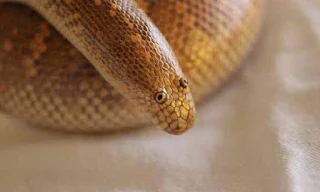Snakes can be frightening creatures; they can be deadly, look terrifying when slithering across the ground and sometimes release toxic venom. Yet not all snakes are fearsome; some just have extremely strange features and amusing features - like this Arabian Sand Boa - an adorable yet harmless species of Saharan sand snake with eyes straight from a child's drawing book!
The Arabian Sand Boa is found across the Arabian Peninsula, including Saudi Arabia, Oman and Iran. These ambush predators have evolved to survive the harsh and dry climate by burrowing partially buried into soil or sand until they detect prey passing by that they need to catch before constricting it and eating it headfirst.
Sand boas are easy and docile creatures to feed in captivity, making them the ideal choice for beginner snake-keepers and disease-resistant. Juveniles should receive one mouse every seven days while adults may require feeding every 10-14 days; to ensure optimal health for both, be sure to vary their diet with various fruits and vegetables that provide vital vitamins for healthful living.
These snakes don't drink much water since their prey provides most of the nutrition. But they still need access to clean and fresh water at all times; provide a shallow dish (large enough for them to soak but not so deep they drown) on the cool side of their enclosure and ensure it remains clean and full at all times.
Temperature gradients are essential to the wellbeing of an Arabian sand boa, much as they would be for other reptiles. A tank should be heated in one area while cooled elsewhere - with an ideal range being between 80 degrees Fahrenheit and 65 degrees Fahrenheit in its warm end. Hygrometers should be used to monitor humidity levels so as to help the snake thrive and flourish.
Contrary to other members of the Boidae family, this snake is unique as an oviparous breeder; meaning that instead of giving birth live young it lays eggs instead. This trait represents an evolutionary anomaly and this case alone outside of Eryx is truly extraordinary.
Sand boa snakes prefer dark spaces or under substrate to hide, so it is crucial to provide them with plenty of hiding places in their enclosure. Hide boxes made of plastic or wood may provide shelter; be sure that it fits inside your snake comfortably with its lid secure; handling is best avoided as handling during shed or feeding periods or other stressful times may stress or agitate them further.













No comments:
Post a Comment